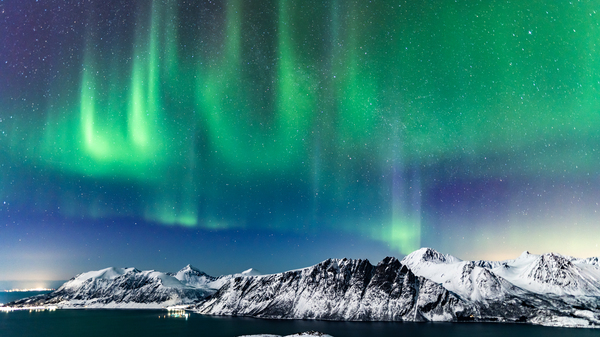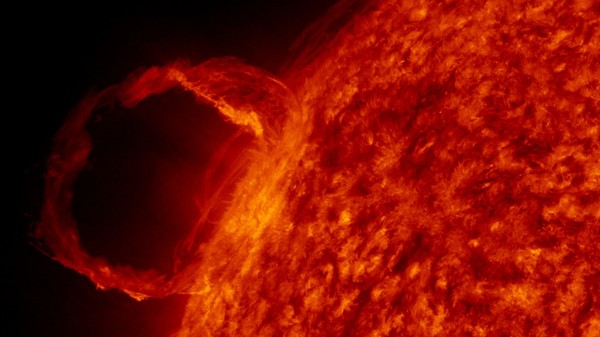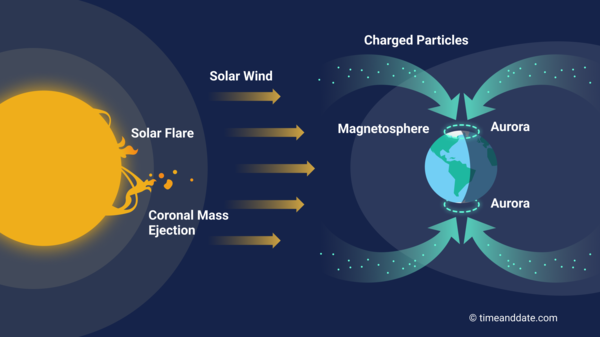Northern Lights: Why 2025 Will Be a Good Year for the Aurora
The aurora has been putting on a show in the night skies recently. If you've missed it, don’t worry—it will be making frequent appearances in 2025, and we're here to tell you why.


A spectacular display of the northern lights in Harstad, northern Norway. Captured by timeanddate.com's Brendan Goodenough.
©timeanddate.com/Brendan Goodenough
The answer lies in the Sun, an enormous engine of energy that influences life on Earth in more ways than we might imagine. The Sun powers these natural wonders through bursts of solar activity, from flares to massive ejections of charged particles.
So, What Are the Northern and Southern Lights?
You’ve probably heard of the northern lights, and maybe even the southern lights, but what exactly are they? Officially, these natural wonders are called the aurora borealis in the Northern Hemisphere and the aurora australis in the Southern Hemisphere.
Both terms refer to the same natural phenomenon: stunning light displays that occur when charged particles from the Sun collide with Earth’s atmosphere. These interactions create mesmerizing waves of green, red, and even purple light that ripple and dance across the sky.
If you’re hoping to catch a glimpse, the best spots are near the poles. For the northern lights, your best chance for aurora viewing is anywhere near the Arctic Circle. Look for dark, clear skies far from light pollution in locations like northern Norway, northern Sweden, Finland, Iceland, Canada, or Alaska.
The southern lights can be more challenging to spot due to the limited landmass near the South Pole. However, you can still catch them in Antarctica, as well as the southern parts of Chile, Argentina, New Zealand, and Australia.
The Sun Blasts Earth with Charged Particles
But what causes these breathtaking displays to appear? To answer this, we've asked our in-house expert astrophysicist, Dr. Renate Mauland-Hus, to help explain the phenomena behind why aurora displays are becoming more frequent and why 2025 promises to be an especially spectacular year for them.
The explanation of why we have auroras here on Earth starts with our home star—the Sun. The Sun has a powerful magnetic field created by the movement of hot, charged gases inside it.
“The magnetic field lines stretch out from the Sun’s interior to the surface and into the solar atmosphere, forming huge loops and arches,” explains Renate.

NASA's Atmospheric Imaging Assembly captured this image of a massive plume of dense plasma erupting from the Sun’s surface. The plasma flows in a loop along a magnetic field line.
©NASA/Earth Observatory
The Sun’s spinning and boiling gases twist these magnetic field lines until they tangle. When the tension gets too great, the lines bend, snap, and reconnect, releasing bursts of energy as solar flares, sometimes accompanied by coronal mass ejections, that can reach Earth.
The breaking and reconnecting of these magnetic field lines is a process called magnetic reconnection. While the Sun’s magnetic field causes both of these phenomena, they are, in fact, different:
- Solar flares: Sudden large bursts of energy that trigger the acceleration of charged particles that flow from the Sun.
- Coronal mass ejections (CMEs): Large bubbles of hot plasma and magnetic field lines that are flung into space from the Sun.
“Though solar flares and CMEs differ, they often occur at the same time as a result of large amounts of energy released during magnetic reconnection,” adds Renate.
The Science Behind the Northern Lights
How are the aurora borealis and aurora australis formed?
Solar activity, like flares and coronal mass ejections, frees charged particles and huge masses of plasma from the Sun, which may then travel to Earth as part of the solar wind.
Luckily, our planet has a built-in defense: the magnetosphere. This invisible shield redirects most of the solar wind, protecting our atmosphere from charged particles. However, some of these particles still manage to sneak past the magnetosphere and enter Earth’s atmosphere, where they interact with the atoms and molecules—mostly nitrogen and oxygen.
“When this happens, the atoms are ‘excited’ to a higher energy state. As they fall back to their natural state, they release light, which is what we see in the sky as the aurora,” notes Renate.


Auroral displays are created by the interaction of atoms, molecules, and charged particles in Earth’s atmosphere.
©timeanddate.com
The solar wind interacts with our magnetic field, and electrons travel along the magnetic field lines towards the magnetic north and south poles.
As the illustration above shows, charged particles can also come from the opposite direction. “This is due to magnetic reconnections that occur in the tail of Earth’s magnetic field. These reconnections create waves that send charged particles rushing back toward Earth’s poles,” explains Renate.
The Sun at Solar Maximum in 2025
So, how does all of this relate to the frequent auroras we are experiencing at the moment? The simple explanation is that in periods of high solar activity, we experience more auroras. This recent increase in aurora activity is directly tied to the Sun’s current solar cycle.
The Sun experiences cycles of activity that peak roughly every 11 years, and right now, Renate explains, “We’re in solar cycle 25, which started at the end of 2019. In October 2024, scientists announced that the Sun had reached its solar maximum period, predicted to last for around a year or so. Therefore, in 2025, we are currently in a period of high solar activity.”
“The absolute peak is predicted to be in July 2025, though this can only be confirmed after it happens,” clarifies Renate.
Interestingly, even after solar maximum, aurora activity can remain strong:
“The solar cycle is now in its maximum period, and we have already experienced high aurora activity in many locations that don’t usually get that much of a display. But, as it turns out, aurora activity can often peak after solar maximum, meaning that the next couple of years will likely be an exciting time for aurora watchers as well.” Renate points out.
With 2025 shaping up to be an exciting time for aurora viewing, keep looking to the skies for a chance to witness these awe-inspiring displays.

